How Hoffenheim fared after the re-start
German Club TSG Hoffenheim has reached 6th place, allowing them to play on the international stage in the upcoming season. How did Hoffenheim perform after the re-start following the Corona-break? What are the key characteristics, including their principal strengths and weaknesses?
TSG Hoffenheim has qualified for the group stage of the Europa League for the upcoming season. The “Kraichgauer“ made 6th place after a 4-0 win against Borussia Dortmund in the last game, overtaking VfL Wolfsburg. On the way to this success, the Hoffenheim demonstrated its strength in ball possession. Nonetheless, injuries of key players and the occasionally lacking consistency are re-emerging aspects. Overall, the strong performances in the four games after the managerial change underline the team’s quality. In the following article we will take a closer look at this team. In doing so, three aspects of the Hoffenheim playing style will be considered: 1) the strong build-up and the role of individual players, 2) the solid play without the ball, and 3) the inconsistent transition-phase – in both offense and defence.
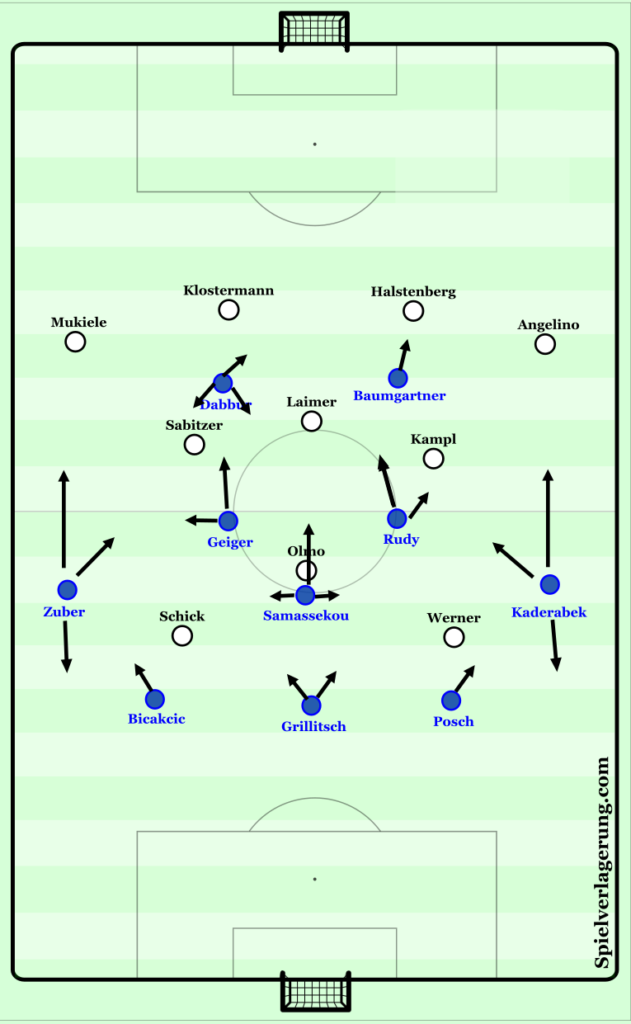
Build-up with several good movement patterns, but link up play further forward can be better prepared
The TSG-team is one of the strongest teams when in possession. Simultaneously, they perform in a system and approach that is supposed to leverage this strength. Hence, Hoffenheim oftentimes assumed an active role while opponents could only sit back and watch Hoffenheim’s actions from a compact structure. For instance, Hertha, Cologne and Augsburg faced the TSG in a defence-focused 4-4-2. For the TSG it was rather difficult to create scoring opportunities against opponents that played in such a system and with such mindsets – especially after the lack of match practice and limited training possibilities during the Corona-break. Hence, the TSG did not find many solutions to create dynamic moments and scoring opportunities in the first game against Hertha in its 4-4-2 block against the ball. Nonetheless, even at this early stage the TSG build-up showed promising patterns. Directly from the defenders the team tried to involve Rudy or Grillitsch. Oftentimes they demand the ball in the zones next to or between the oppositional forwards. Additionally, the offensive half-spaces were targeted. While the spaces between the opposition lines played a central role in the build-up approach, the flanks were rather rarely used as transit area to get into the offense zones. Situations in which the ball ended up on the flanks were rather unsystematic in their nature and often random instead of being strategically prepared and tactically utilized. When holding the ball and in build-up the own central defenders, and the wing-backs – Zuber on the left and Skov on the right wing, tried to position themselves between the opposition lines. The team did a good job in identifying and occupying positions in such spaces with appropriate distances to oppositional players. The following two scenes demonstrate the TSG’s ability to effectively use the half spaces to create dynamic for the following play.
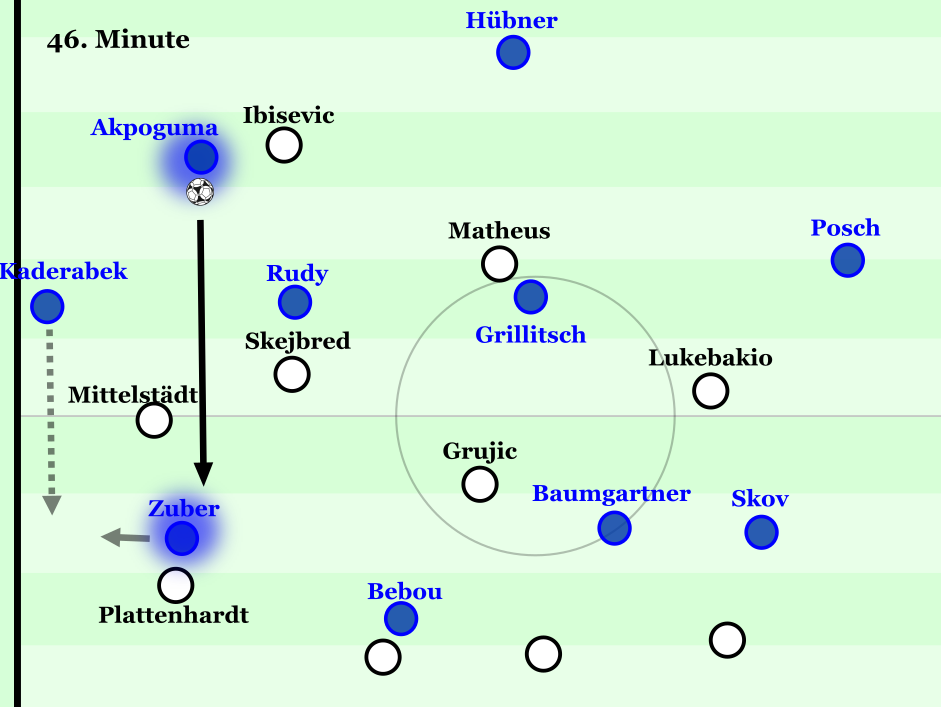
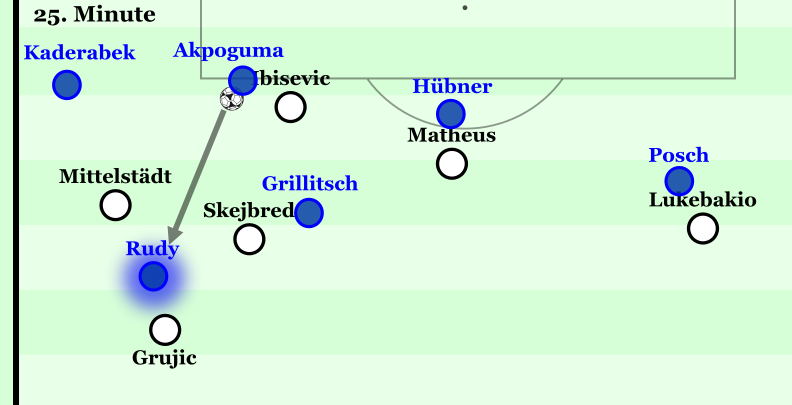
While Akpoguma passes to Zuber who is positioned in the offensive half-space (scene 1a). Zuber continues the play with a pass to Rudy (scene 2a). Once Hertha confronted the TSG in a structured formation in a midfield pressing, difficulties arose to pick up speed and find both space in deeper zones and identify vertical pass lanes. The reason why finding of space actually did work in some moments was Hoffenheim’s strong technical and playmaking ability in ball possession. In addition, the team managed to involve the strong players on the 6 and showed flexible movements in frontal zones by e.g. Bebou or Baumgartner. We will look at these movements in greater detail below.
In scene 2a the TSG seemed to deliberately attract the oppositional players to higher zones. Such patterns in pulling the opponent out and apart were symbolic. Once the opponent attacks up front, clearly the TSG has the potential to find build-up solutions even under such great pressure. The further development and translation of such attacks into scoring opportunities provides room for improvement though. More on that point below, too.
In general, Hoffenheim is able to create dangerous situations once the team entered the opponent´s half. Scene 3 exemplifies this, showing Baumgartner’s clear-cut chance. Grillitsch passes to the well positioned Skov. Kaderabek acts proactively and prepares the ensuing situation with his run.
Role of Grillitsch and further group-based movement patterns
The key and initiating player in scene 3, Grillitsch, contributes to great plays on a both individual and group-based level. He integrates teammates through his passing ability or carries the game forward with a dribble. The Austrian does good for his team through his incentivising and energetic nature. In the build-up – as mentioned shortly above – he often drops between the central defenders. The underlying idea is to create a “+1-situation“ to outnumber the opponent in the first phase of the build-up. This could be observed in almost all games after the re-start. This basic idea and the thereon coordinated movements are for the central defenders to fan out. Hence, while they have better angles for vertical opening passes to build up, it is also harder for opponents to pressure them.
Moreover, the TSG tried to utilize reverse movements and positional changes between the wing player (e.g. Zuber) and the 8 (e.g. Baumgartner) in the games against Hertha and Paderborn. These mechanisms were aimed at unwinding man-to-man markings, opening spaces and bringing dynamic to the build-up play. Similarly, Werder Bremen used such positional changes against the BVB to break up the man-oriented markings, but also to keep the Dortmund players busy and open passing lanes to key player Rashica, e.g. through shifts between half-spaces. However, the TSG did not coordinate this tactic mechanism well and applied it too mechanically. The selection of opportunities seemed rather incoherent rather than clear and focused. Therefore, these attempts did not help the team to carry on own attacks. As this tactic did not bring any clear advantage and would have required more effort for refine for the coaching team, it was only applied rarely. Nonetheless, such positional changes offer a certain flexibility to change the positional dynamics in the build-up phase especially against man-markings. Possibly, such mechanisms could become more relevant in the future if focused on in practice and well-tested in matches.
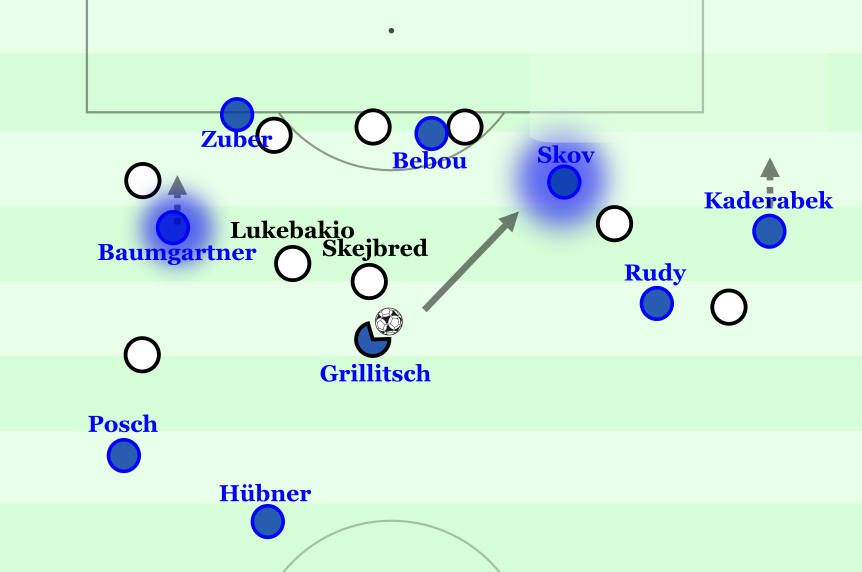
While transition into the half-spaces was well managed in several scenes, Hoffenheim lost the option to get into this valuable space in the course of an attack too early. In this context, the role of Rudy can be discussed. Together with Grillitsch he assumes a dominant role in TSG’s build-up. His involvement and situational positioning can be managed better and more flexible in order to optimise options in the build-up. Following exemplary scene underlines this point (scene 4). While Akpoguma dribbles forward, Rudy directly supports and provides a safe pass option. However, he limits the options Akpoguma has through his running path. As depicted in the graph, he closes a potential pass lane to Skov through his cover shadow. If Rudy orientated himself towards the centre, he could attract the attention of Ibisevic and Skejbred. Whether a pass from Rudy to Skov would have become possible through this potential run and positioning is not certain. Nonetheless, the likelihood for such a passing option would be considerably higher. In the best scenario Skejbred is restrained from narrowing the passing lane to Skov. If Kaderabek does move a few steps higher towards Mittelstadt and the sideline, the passing lane to Skov possibly becomes wider. This way Kaderabek could also be involved in a following action. In general, Rudy created several good situations and plays, but remarkably often missed the appropriate moment for the next pass or run to open room for his teammates. Noteworthy, Hoffenheim decided to not sign Rudy for around 6 million euros after the season. This presumably has a wide array of reasons including Hoffenheim’s midfield options, the Corona-situation, but also his role and performances.
Further interesting structures in build-up happened when Grillitsch stayed centrally in front of the own box, while Rudy dropped to right next to the central defenders on the wing-back position. This made the creation of a wider build-up line possible. Consequently, this structure helped to pull the opponent apart, allowing Kaderabek to push forward and enabling new dynamics and passing lanes. What is more, Grillitsch drifted in several situations next to the central defenders, while Baumgartner dropped from higher zones.
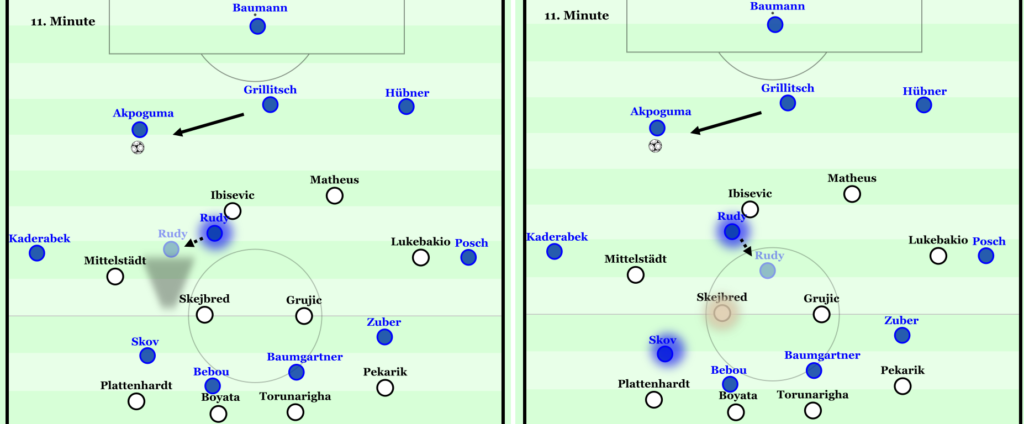
Options for following actions are occasionally missing after transitions in half-spaces
The selection of moments for transitions – in particular through the half-spaces – require a high level of sensitivity and good timing to choose the right moment. Such plays could create instability within seconds when executed with the wrong structure. The TSG handled such transitions well by generally finding the optimal balance between risk-taking passes and patient ball possession. Inconsiderate ball turnovers were rare. Especially in the first few matches after the restart, the TSG showed greater potential to build on the good foundation in build-up by adding group-tactical runs and positioning to prepare following attacks.
While the team succeeds in positioning in space and timing of passes into the half spaces (see scenes 1a and 2b), the exemplary situations also emphasize the unfavorable structures the team occasionally creates. These structural aspects are an issue rather on the team- than on the individual level. Once the TSG passed the ball to a player positioned in the half-space, this player is often isolated from the overall team. This structure exacerbates the options to continue the attack after vertical passes. Further movements and more proactive positioning of teammates are necessary to exploit the potentially valuable ball possession in the half-space. Such supporting movements on the team level appeared rather unstructured and passive. The TSG did not manage to have sufficient players to push up to the next zone to create effective connections as foundation to carry the game forth. Overall, the TSG could have used the surrounding spaces more effectively.
Given such unfavourable structures by Hoffenheim, it was not hard for opponents to attack the isolated player and cover the zone the TSG had targeted. From TSG’s point of view, the creation of options for passes back into the build-up zone would have helped to alleviate the increased pressure in the half-space. For instance, in situations the TSG targeted the half-space and then played back in the first zone after the opponent had covered the room, horizontal shifts could have been a promising strategical means. However, the TSG could seldomly made use of passes back in the first zone or short lay-offs to create additional dynamic for further shifts. The individual opportunities to control the ball and turn in the room between the oppositional lines was not sufficient to create penetrating power constantly. The reason for this missing consistency in these moments was due to lacking options to continue the play out of these positions. Overall, the TSG showed some strong plays, diverse and flexible build-up structures, and forward movements after vertical plays. However, such vertical plays provided room for improvements when considering the team structure and when taking the entire 90 minutes into account. There are two exemplary situations that symbolize these observations.
In scene 2a Rudy receives the ball from Akpoguma even under oppositional pressure. In the subsequent action the vast (!) space in the centre, created through the outplay of the Hertha frontline, is not leveraged. Runs by Grillitisch and/or Bebou would have helped to exploit the dynamics and use the created space efficiently. Since both of them wait for an action of Rudy and adapt too late to the new structure (Grillitsch’s run to the front comes too late), Rudy does not see the potential space in the centre due to the pressure by Grujic. (Admittedly, the scene ends with a long ball to Skov, who gets in a favourable position within the box. Still, the way this scene was played versus how it could have been played through proactive runs and positional adaptions offers room for discussion.)
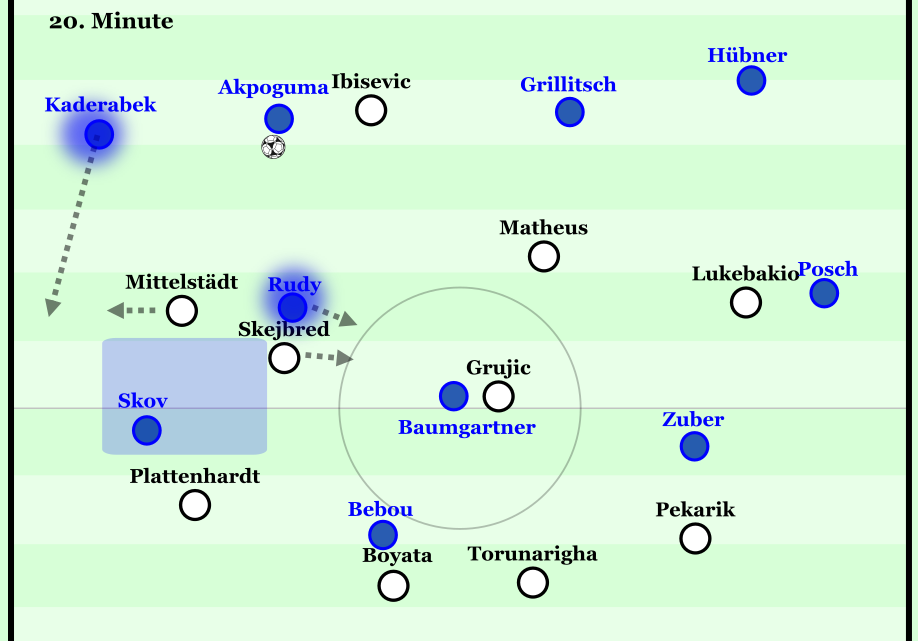
situation is not well played. Bebou and Grillitsch are missing the
moment for runs and positional adaptions to support Rudy. The
created space in the centre is not leveraged.
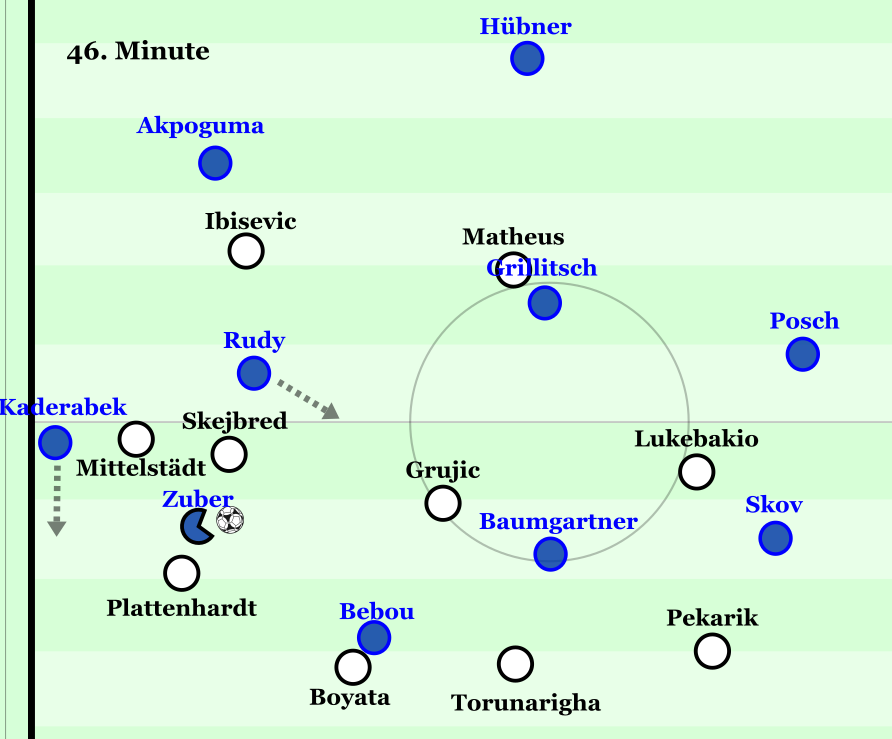
There is a similar picture given in Scene 2b. Akpoguma passes to Zuber. Despite the ball possession in this strategically valuable space, the situation offered greater potential to prepare following options through positional adaptions and runs. On the one side, Kaderabek could move forward once Akpoguma passes the ball to Zuber. This way, a potential 2vs1-situation with Zuber and Kaderabek against Plattenhardt could have been created – depending on how quickly Mittelstädt had reacted to defended contrary to his movement forwards. On the other side Rudy could present himself earlier for a pass from Zuber in the open space – with the advantage of an open field of vision to continue the following play.
Another situation (scene 5) underlines the potential value of further mechanisms in build-up to improve the options to continue an attack. Here, the orientation and respective movement towards the centre could open up a possible passing lane to Skov. In a similar vein, Kaderabek can contribute through a supporting run. He would not even have to move up to Mittelstadt entirely, but a few meters up vertically would already catch a greater attention of his oppositional player.
Eventually, Kaderabek gets the ball due to limited alternatives for Akpoguma. Ironically, in the new situation immediately afterwards there is the opportunity for a promising long ball to the wing. Skov and Baumgartner had pulled their opponents into the centre. Akpoguma is under no pressure. The wing is unoccupied. This option comes somewhat surprising given the relatively static situation before. While Hertha could have isolated Baumgartner easily near the sideline in such a possible scenario, this pass would have still offered a good opportunity to get into this open space past the majority of Hertha players. Thus, it seems interesting, that the rather passive build-up play in this situation leads to such an option.
In a similar vein this scene emphasizes that the wings in Hertha’s 4-4-2 relied on quick shifting movements to stabilize and establish compactness in the centre. Consequently, the mentioned play through a third player – e.g. bringing the ball to Kaderabek by playing through another player the half space – provided a great option to start an attack. In this context there were some situations in which an overrun on the wing was a proper means to outnumber the opponent and play out a situation to create a scoring opportunity.
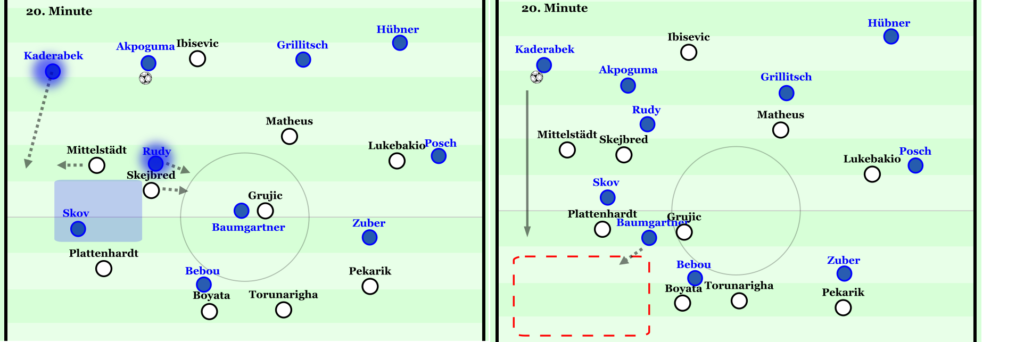
Incremental structural adaptions
In the course of the 10 games, TSG’s positioning and structure in ball possession did improve step by step. In the overall picture, the mentioned dynamics and approaches were implemented more thoroughly, determined and balanced. Grillitsch dropped more constantly and well-timed between the own central defenders so that they could move wider in turn. This tactical mechanism was not played too schematically but was complemented by other patterns. Hence, the initially unassertive dropping movements between the defenders in the first build-up line were shown more often. Remarkably, in one situation Grillitsch did not drop diagonally in the first line but drifted horizontally towards the sideline. This way the midfielder was able to receive the ball from Posch next to the oppositional block, gain space and be favourably positioned for the following play.
Aside from adaptions in these tactics, Hoffenheim improved in the structural occupation and utilization of space between the defenders (i.e. back four) and midfielders. In terms of the individual unit and team tactics, the TSG increasingly optimized their positional structure by occupying different horizonal and vertical lines. Hence the domination and flexibility in positional adaptions became better. For instance, against Cologne the TSG-team successfully targeted players positioned in the space within the oppositional 4-4-1-1 more frequently. An important factor in the increasingly better utilization of the entire pitch were the adaptions in midfield as well as the better occupation of wider zones. In contrast to the first games against Hertha and Paderborn, there was a more spacious foundation in the play. The half-spaces were occupied by the two respective players on the 8. Therefore, the wings – e.g. Larsen and Skov – could position in wider areas and did not linger in the half-spaces. Additionally, the wing backs moved up more frequently, especially after dropping movements of Grillitsch in the first line and the resulting wider positionings of the central defenders. This structuring of the unit enabled the defenders to dribble towards the oppositional block more appropriately to continue the play and not get under pressure and isolated without options to continue. These improvements also gave the central defenders more time in build-up and hence allowed to play a more precise long pass in some situations.
All of this was favourable for the development of the build-up in the course of the ten games. Degrees for passes were often more favourably due to the stated patterns. In addition, there were more options for the player in ball possession. This also had positive consequences for the strategic decision-making, e.g. when to advance or terminate an attack, when to shift sides or when to slow down the dynamics of a situation. While the build-up encompassed several good mechanisms in the first games (e.g. against Hertha), there was a lack of options to continue an attack every now and then, especially in the half-spaces. More present occupation of the space between the oppositional lines, more movements and dynamics in the half-spaces, and quick combinations against Cologne and Mainz brought a progress. The mentioned changes in the half-space and in the positioning of the wing-backs did indeed result in more favourable structures for following actions. For instance, Kaderabek was positioned slightly higher in many situations and reacted more proactively in moving forward even if he was not involved in the attack yet. Nonetheless he still showed further room for improvement for vertical runs in higher zones by starting and coordinating such movements with the group- tactical patterns (see scene 6).
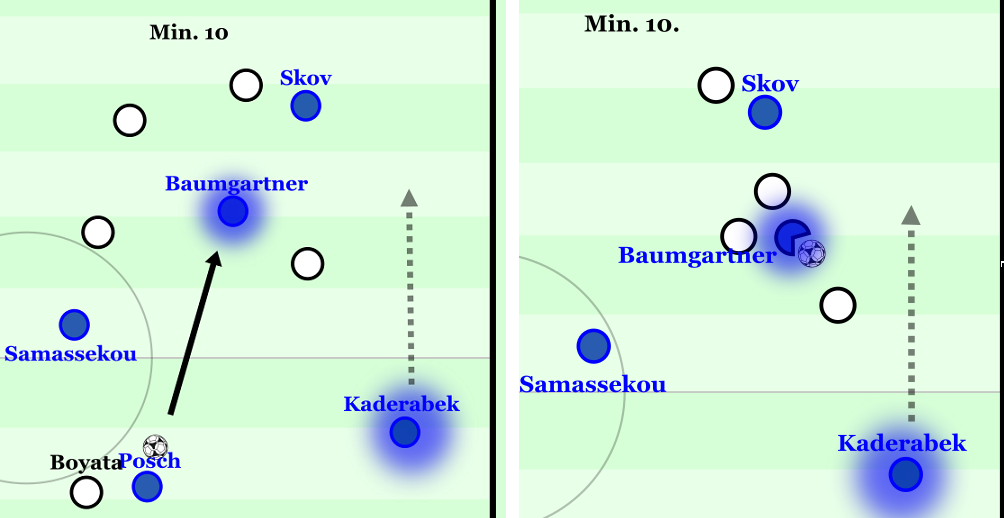
Despite the lack of such options to continue certain attacks from ball possession in higher zones, the TSG increasingly improved in their behaviour in build-up and play in ball possession. Specifically, their actions while possessing the ball became more patient and deliberate. The Kraichgauer showed better timing for transitions into higher zones in the appropriate point of time when own positional shifts in the early build-up had forced unclear reactions by the opponent. In the first games the ball-near midfielder – especially Rudy – supported the central defender in ball possession actively by approaching them within a short distance. This support often took place too ambitiously and too rashly, closing or covering open men in higher zones and creating unfavourable structures. Fortunately, the TSG increasingly used back passes to deliberately shift the play during an attack. Exactly this happened right before the 1-0 against Cologne when Posch got back the ball after his prior vertical pass and shifted the play to Hubner. Through the implied play towards the right half-space, Hubner on the left side had more space and time to play the long pass to Larsen after he had received the pass from Posch. Larsen, in turn, bluffed a movement towards the centre, but passed by his opponent vertically.
Not least, Hoffenheim showed a good movement off the ball before the disallowed goal by Baumgartner in this game (min. 41). Generally, well-timed diagonal and wide-ranging passes complete the flexible build-up structures. Towards the end of the season, the way Hoffenheim handled the build-up seemed more sophisticated and considerate. While inaccurate passes caused troubles in individual build-up situations, they did not result in too much danger or oppositional goals as in the game against Paderborn.
Play in deep zones – Role of Bebou, Dabbur and Baumgartner
One did not realize that the TSG lacked a striker which is great at positioning and acts as flexible support player in deep zones. Bebou often occupied the position up front. He assumed an important role in targeting the half-spaces or spaces between the oppositional lines. In his appearances, he often positioned himself between the oppositional lines to exacerbate marking for opponents, increasing the likelihood to become involved as open man in the course of an attack. The positioning of Bebou was generally done well, and could have complemented with flexible tactics of the attacking unit(see above). For instance, Bebou could have moved in the space between the oppositional central defender and wing-back against Hertha. Such movements could have helped to keep the opposition defensive line high, increasing the room available in the half-spaces without compromising the connections. This positioning along with a greater offensive integration of Kaderabek and respective covering by Rudy could have supported the attacks. Additionally, dynamic supporting movements for the ball carrier – e.g. through a short layoff and following vertical run – could have been an interesting involvement of Bebou. This way, man-focused coverings could have been broken up.
While Bebou does not suit the profile of this role, another potential forward, Belfodil, was still missing due to an injury. Further, youngster Beier could not put his mark on the team yet given his age and little experience on this level. Exactly for these considerations, striker Dabbur was signed in the winter transfer window. As soon as the striker was ready to play, he proved to bring promising characteristics in the position up front, indicating his potential to create dynamic in small spaces. Multiple times the Israeli was involved in actions in ball possession and build-up (see scene 7). He demonstrated great timing for supporting runs or marginal positional adjustments and a good ability to play high-class lay-offs. For example, he was involved in the scene leading to the red card of Bornauw (min. 24) against Cologne. Now and then he missed to find the optimal position or to coordinate properly with his teammates (e.g. Dabbur and Baumgartner dropped in the same space). What is more, Dabbur’s quality in transition moments thanks to his acceleration, speed of execution and sense for spaces shone through. When his team scored the 2-0 against Cologne, he contributed through a short touch bringing the ball to Skov before his assist to Baumgartner. While rather unnoticed, this touch was of great importance to create the scoring opportunity. Overall, Dabbur seems to enhance the game in ball possession as flexible supporting and open player for lay-offs and short touches.
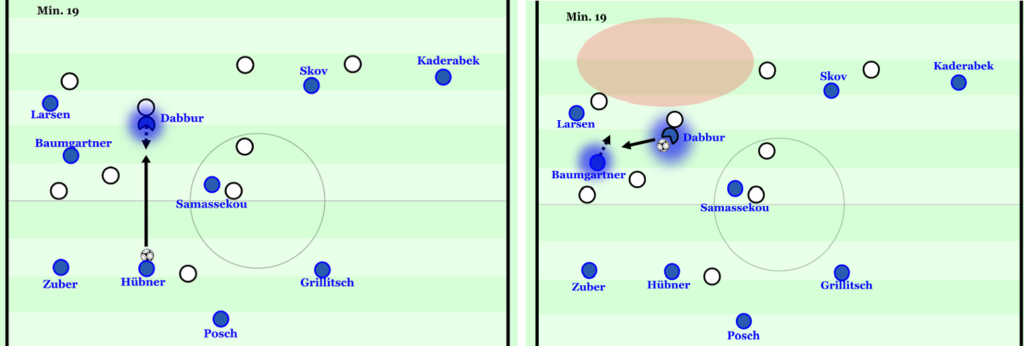
Besides Dabbur, Baumgartner showed his meaningful role in the TSG game. Both players can complement each other to create dynamism from static moments. They can support each other in the room between the oppositional lines to play through the central block even against compact formations. Baumgartner impresses with great timing in releasing himself from opponents and occupying half-space or narrow spaces. He became increasingly important for the creation of pace and, in turn, the exploitation of dynamic moments created by his teammates. His well-timed vertical runs and occupations of rooms created impact in almost all games. The exemplary situation with the clear-cut chance of Baumgartner was already mentioned above (scene 3). Baumgartner’s flexible role raised problems for the opponent not just in this situation. The Austrian’s supporting movements contributed to create connections within the own formation – e.g. through triangle structures – with the duos on the wings. This way, some favourable structures were made possible. However, diagonal plays towards the centre of the pitch lacked the final anticipating positioning or run to continue an attack from a group-tactical standpoint. This lack did not occur to a dramatic extent but was rather the last grain to succeed. Still, it was enough to raise difficulties to finalize attacks and eventually to score for the TSG against disciplined oppositional defensive lines. The attacks of the TSG and specifically of Baumgartner are characterized through a general fluent play. For example, Hertha could not adjust to his multi-faceted movements and faced tough challenges in decision-making in shifting. On the one side Baumgartner was able to open spaces for teammates or to provide an open option in creating an attack (min. 62). On the other side he was able to exploit pace created by teammates and assume the role as final player in an attack. This characteristic which is indicated through great timing in occupying spaces and vertical runs is often underestimated (Marcus Thuram is extraordinary here). Thus, Baumgartner could assume an interesting and critical role in the future.
The TSG plays disciplined without the ball, but shows occasional coordination issues
Right from the beginning of the re-start-games, the TSG showed a solid performance in the phase when the opponent held the ball. The TSG-midfield supported the own defenders actively and quickly after vertical passes by Hertha up front. The players on the 6, Grillitsch and Rudy, defended wide spaces and often made long-range shifts towards the wings. This seemed well coordinated, since the other 6 respectively assumed responsibility to cover the empty space. Only in individual situations the focus on the option- finding process in the offense went in favour of defence covering. For instance, in one situation Rudy and Grillitsch were both pulled out to the wing, revealing a great space behind them for the opponent to leverage. Further, Hoffenheim showed to be stable and solid in defending long passes despite a few individual errors (e.g. of Hubner against Hertha’s Ibisevic). Merely individual moves in the phase against the ball raised problem. In such situations minor coordination problems occurred and the TSG acted too hesitantly. One situation at the beginning of the game was symbolic, resulting in Matheus’s shot on goal (scene 8) and the situation with the scoring opportunity by Ibisevic in early second half. This situation only arose, because Baumgartner moved up to Skejbred too late, allowing him to play an opening pass to Lukebakio without pressure (scene 8).

Not just in this game though, the general solid level in the phase against the ball could be kept consistently for 90 minutes. While the intensity against the ball – and often in the transition into defence after ball losses – was held up for a considerable time, the TSG lost this level during the second half. The Kraichgauer had difficulties to reestablish the intended structure or hold up the runs challenging the opponent and cover the open men by using cover shadows. Often times there were minor coordination problems to react and support positional shifts of teammates or to increase the pressure on the ball carrier by isolating him and reducing his options to continue the play. Against Hertha, the substitution of Bebou arguably played a role. His disciplined and intensive attacking runs were a critical factor against the oppositional build-up. In this regard Beier could not replace him with similar quality. To what extent the role as only striker in a 4-1-4-1 fits to Beier’s player profile offers room for discussion.
Waning intensity against//without the ball or individual errors?
Eventually individual errors in direct challenges for the ball on the right side appeared to be decisive in the game against Hertha. In the scenes leading to the 0-2 and 0-3, the involved TSG-players react too hastily and impatiently rather than deliberately facing the oppositional players. Movements and runs became rashly without curbing the opponent’s attack. But that’s only half the story. In the situation leading to the 0-1 the TSG cannot challenge the opponent’s ball possession. The general intensity – the runs to challenge the ball and movements in the defensive transition – decreased steadily. In spite of the rather unfortunate interplay of situations leading to the conceded goal, the Hertha controls the ball for a long time and does not get sufficiently pressured before playing the diagonal ball. This waning intensity resulted in unusually large spaces and time available for Berlin, helping them to become more confident and deliberate in their actions. This way Hertha could access the wings relatively easily in the scenes leading to the 0-2 and 0-3. The TSG did not react appropriately and behaved too passively when the opponent passed the ball to the wings. This passivity had further consequences. First and foremost, the scene leading to the 0-2 underlines that Hertha was able to create 1vs1-situations in promising offensive zones – with a high reward if it works, but little risk in case of a ball loss. Specifically, apart from the TSG-player directly involved in the challenge, no additional teammate was able to support after the challenge was lost. This way the TSG-structure and man-allocations went to pieces, getting reduced to individual 1vs1-situations on the wing with little covering. It became apparent that the TSG did not react well to support and cover teammates. In the situation leading to the 0-3 Akpoguma had to move widely out of the back four. Kaderabek is not able to step in anymore, because he orientates too strongly towards his direct opposing player and does not cover the space behind Akpoguma. Noticeably, the TSG players supported and doubled each other less intensively when the opponent brought the ball to the wings. Hence, the formations became less compact in specific parts and distances between TSG players grew too large, limiting effective covering.
Overall, there were inconstancies in defensive tactics in the box and on the wings, and in general defensive behavior in a deeply positioned, compact block. These inconstancies were revealed every now and then by opponents. The waning intensity against/without the ball allowed opponents to take on momentum (e.g. Hertha in the second half). Another factor was the inability to curb the opposition attacking rhythm. While Hertha used fouls as means to disrupt Hoffenheim’s flow of play, the TSG themselves did not use such means when the opponent gained the upper hand. Instead they merely reacted to the challenges the opponent raised. Further, the TSG did not manage to exercise control through own possession by moderating pace and dynamics in rather unsettled and restless phases.
In the course of the following games one could notice that the emphasis in training were laid upon – as illustrated above – the behavior in build-up and in ball possession in general. It was sufficient to perform solidly at average intensity against the ball. It was more about coming unscathed through this phase and to shape the game once in ball possession. Sophisticated ideas to enforce for ball wins in specific zones and strategic considerations concerning the height and zones for the pressing line appeared scarce. In contrast to the play in ball possession, there were not many changes in Hoffenheim’s approach against the ball during the ten games after the re-start.
Samassekou’s initial inconsistence, but increasing important role
Hoffenheim oftentimes formed a 4-1-4-1. The role of individual players differed in certain phases. Against Cologne the players on the 8 faced their direct opponents over long distances. Samassekou on the 6 moved far to the front in specific situations to challenge balls or to hinder opponent to control and turn with the ball easily. Overall, the role of Samassekou can be addressed at this point. Above we already looked at a few aspects and contributions from his side in individual scenes. The midfielder is an excellent player to challenge and win balls by aggressively and actively confronting his opponents. Simultaneously, he can play difficult passes and combinations in rather unstructured situations and liberate from oppositional pressure through dribbles. In some situations, he showed his ability to contribute to build-up, too. Moreover, he seems to feel comfortable in rather narrow and small-scale spaces and to solve such situations through skilful positioning or to apply a short dribble to pass an opponent and to target open space for teammates. This ability in combination with his pressing resistance can potentially enrich the play of his team.
What is more, he fulfils his task in the phase against the ball usually well, showing great potential in this role. He was involved in some important tackles and wins of possession. Further, the midfielder is good at assessing game situations and timing in forward movements to challenge opponents. Thanks to his athleticism and speed, Samassekou is able to come out on top of many close challenges and to choke off potential oppositional attacks. All this means that he assumed an increasingly important role against the ball, covering attacks of his team, and ensuring general defensive stability. Overall, while his performances were inconsistent, Samassekou showed promising elements which – together with his strong skill and intensity in challenging balls and pressure opponents – can become a critical element for his team in the future.
When facing the opponent in a 4-1-4-1, Samassekou was often the only player who occupied Hoffenheim’s room on the 6 between the back four and the midfield line (e.g. in the games against RB Leipzig and Cologne). The half-spaces next to him were a potential zone the opponent could exploited in their overall team-based attacking approach. For the TSG these areas were a potential source of danger, especially in situations when the players in more offensive zones, often Grillitsch or Baumgartner, could not close the passing lanes through their cover shadows. These potentially dangerous spots were also targeted by starting attacks over the wings and then getting diagonally into these rooms – such considerations were for instance part of Leipzig’s and Cologne’s approach against Hoffenheim.
In this context, Samassekou executes horizontal shift too hesitantly to cover optimally for his teammates. Usually, not just Samassekou is involved her but rather group- and team-based inattentiveness are responsible. In contrast to the oftentimes good vertical movements, one can observe Samassekou being neglectful in certain situations over the course of the 90 minutes. However, thanks to his aforementioned speed and intensity, he can smooth out most errors. Nonetheless in the phase against the ball improvements in horizontal shifts are necessary to bring his contribution to the next level.
Furthermore, finding the appropriate distances between the central defenders and Samassekou has been a re-occurring topic. Often, the distances were not suitable to enable stability in the course of 90 minutes. For instance, this issue became apparent in the game against Cologne. Especially in the second half after Hubner was sent off with a red card, the distances did not work well to increase pressure on the oppositional ball carrier and cover for the moved out teammate. The TSG did not deal well with the situation of having one offensive player less on the field, and had difficulties to close the rooms for the opponent against the ball. Cologne was able to start attacks especially on the right wing, where Larsen was missing now – due to his substitution to replace Hubner in the back-four. Hoffenheim did not adapt its formation and situational positioning properly.
Upside potential of further mechanisms in the phase against the ball
When facing an opponent in ball possession, the distances and intensity in shifting and the pressure onto the ball are generally good. Only in individual phases or situations this usually good level is not held up. For instance, this was an issue in the second half against Hertha. Against Cologne, in turn, the TSG often approached Cologne’s build-up in very high zones early on. Especially after the managerial change with the interim coaching team the opponent was attacked aggressively near their own box. We will look at these adaptions under the interim coaching team further down.
Under the pressure by the TSG, Cologne did often play and liberate by means of long-distance passes. To push for ball wins in frontal zones – and in view of players like Baumgartner, Grillitsch and Samassekou – the TSG could possibly set pressing traps in certain situations. In one scene when Hoffenheim pressed close to the oppositional box, an opportunity to set such a trap opened up (scene 9). Goaly Horn has the ball and is attacked by Dabbur from the side. Since Skov closes the room on the right, the only option for Horn seems to be the option to open through the centre to the player on the 6. Once this player receives the ball, he passes to the right-back who plays a long-distance pass. On the one side the TSG pressing was successful in this scene since Cologne was forced to play the long-distance, rather uncontrolled pass. On the other side Hoffenheim could strive for more: to win the ball in such valuable zones in this or similar situations, e.g. by deluding the opponent and misleading him towards a build-up attempt the TSG is prepared to attack. The approach to create such mechanisms and structures already provide a foundation to build on: The pass into the centre is played. If Dabbur – and possibly Larsen – make it harder to play the pass to the right-back, the player in the centre can be attracted to control the ball, providing some key seconds to steal it.
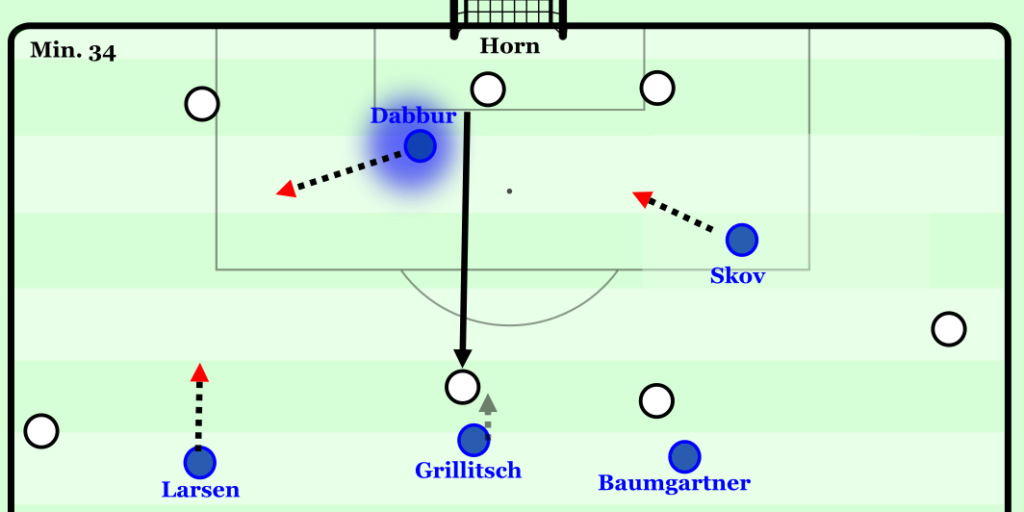
Adaptation under the new coaching team – different pressing tactics
The general strategy and approach without the ball were slightly adapted at the end of the season. The decisive factor was a managerial change. After the takeover of the interim coaching team with Matthias Kaltenbach at the front, the aggressiveness and intensity of the pressing changed. A look at the PPDA already indicates an adaption by the coaching team: While the PPDA assumed a value of around 16 (against Hertha) and 21 (Cologne), the number decreased to 13 (Union Berlin), 7 (Augsburg) and 9 (RB Leipzig). The new approach was directed at aggressively and deliberately forcing ball wins and to assume a more dominant and determined role. Right in the first game against RB Leipzig, the TSG appeared with greater general stability – even if the two conceded goals in the first half seem to give a different picture. One factor here was that the team needed some time to apply the new input. For instance, the timing in approaching the opponent and in pushing up in accordance with teammates was not coordinated well immediately, but only appeared increasingly better in the following games against Augsburg, Union and BVB. The wing-backs covered wide spaces and pushed up aggressively – but sometimes challenged the oppositional player a moment too late. Overall, the high-attacking approach and the according behavioural group patterns fit to the player profiles. Concerning individual tactical aspects, Rudy was responsible to hinder Kampl from getting the ball too often and – once he had it – to limit his time and options to a minimum. This inhibited RB’s build-up and flow of play considerably. This way Leipzig was not able to establish a dominant role in ball possession and build-up deliberately. However, for the TSG it finally came down to defending horizontal lay-offs or passes in the back. Hoffenheim did not prevent such direct lay-offs after shifting passes by RB attentively. Room for improvement can be found firstly in the formational structure with mutual covering even after wide shifts against the ball, and secondly the correct attitude to defend and make supporting runs for the defence of the attacking and midfield players even after they were already outplayed.
Inaccuracies hinder finishing promising opportunities after transitions
As stated previously, the creation of promising situations often rooted in a preceding deliberate build-up moment including a certain number of passes, passing combinations and variable runs to break up the oppositional structure and man-based markings. The best opportunities arose from deliberate build-up or play in ball possession in general. Further, the TSG occasionally used transitional moments to their advantage to create scoring opportunities. Transition after winning back the ball against compact and deeply positioned opponents proved to pose difficulties for Hoffenheim though. Once the TSG succeeded in stealing the ball and managed to pick up speed immediately, the team showed great ability and certainly has players with the appropriate profiles to
create and exploit oppositional disorganization. This was evident against the Hertha, although the team was well organized and covered solidly, especially in the centre across its 4-4-2. One example involves the situation which led to a scoring opportunity for Beier and Grillitsch (70th min.). Despite these advantageous turnovers, the eventual determination in certain situations was still lacking. Minor inaccuracies and unfocused moments limited the advancement of potential transition moments. An example in scene 10: Skov wins the ball and passes to Rudy. Now, two minor mistakes happen, which reduce the promising starting position to nothing. First, Skov passes the ball slightly in Rudy´s back rather than serving it in his movement forward. Thereby, he loses considerable pace and has to re-orientate once he brings the ball under control. In turn, Hertha wins time to challenge the opponent and cover the dangerous zones. Second, Rudy also makes a rather inaccurate pass that doesn’t reach Skov. The direct pass to Kaderabek would have been fine. Thus, the depicted scene emphasizes the occasional lack of calmness, sense and decision for the right pass or movement in such rather unstructured and hasty situations.

Despite the relatively minor focus on this game phase, the TSG showed good moments and solutions due to their general talent and individual ability in solving unstructured situations. Against Cologne, two well performed transition moments before the 2-0 and 3-0 paved the way to victory. These situations involved elements from behaviour against the ball, transition moments, and the creation of scoring opportunities in spite of compact an oppositional defence. Hence, transitioning was important, but it was not a classic counter-attack. The situation leading to the 3-0 was similar to one in ball possession, requiring play through rather narrow spaces. These strengths can only help in preparing and exploiting transition moments especially in during its early stage.
Beyond such individual scenes, transitioning after ball wins is not the most critical phase in the TSG play. Generally, the Hoffenheim is able to start an attack after a transition once this individual player manages to quickly move through space and accelerate, or if this player finds a team mate to do so. If the situation works that way, further actions are executed with a decent intensity on the part of the directly involved players. This is sufficient to leverage some situations and get into dangerous zones every now and then. It is positive that the TSG has many players that are good playing combinations, stay on top of the situation even in dynamic moments and hence can enter spaces by playing quick passes. Dabbur in the front seems to be a valuable player given his speed of execution and acceleration over short distances. This way he contributed at the mentioned 2-0 through a one-touch-drop.
However, sometimes minor aspects are missing or are not executed properly, hindering the eventual creation of scoring opportunities. Oftentimes, situations end in an unprecise pass or an opponent manages to block the ball in the last second. Such moments revealed potential for improvement, because players that were initially not involved could have facilitated the situation in the moment of the ball win through corresponding runs. Thus, in some situations the expeditious occupation of width and depth around the player who successfully challenges the ball would help with the unit as a whole. Therefore, an element that Hoffenheim sometimes lacks against teams that are strong in transitioning into defence encompasses dynamic and clever positioning such as expeditious occupation of rooms immediately after the ball win. Since the majority of teams in the Bundesliga are solid in counter pressing tactics, one has to execute the offensive transition moment very well in order to exploit it. Hence, there is more potential for group-based positioning and running patterns.
Reliable transitioning after ball losses despite individual weakness in covering for each other
The TSG is rather inconsistent in transitions after losing the ball. In the course of several games the quality in defensive transitions was rather erratic. While this facet of the TSG game was solid over long periods, it was a source of vulnerability in individual situations. Above the conceded goals against RB Leipzig were illustrated. Such vulnerabilities often rooted in formational structures in ball possession. In the moment when the TSG lost the ball, the structure appeared to be not optimally prepared to enter the transition moment and immediately start counter pressing. A concrete example relates to the situation in minute 35 against Hertha: Grillitsch possesses the ball but loses it. On the one side this ball loss was an individually lost challenge and rooted in a bad decision to start a dribble. On the other side the structure was not favourable, neither to continue the attack nor to cover in case of a ball loss. Samassekou and Skov narrow the space in front of Grillitsch. Kaderabek could move forward on the wing for a potential pass from Skov, if he received the ball from Grillitsch. Alternatively, Kaderabek could act with a focus on covering his teammates by moving in by a few steps. This way he could possibly shift the entire attack in the open central space to Zuber if he received a pass from Grillitsch. Overall, the approach and tactics of the individual units and the team as a whole seem to be focused on dynamic, man-focused orientations. These patterns are sufficient and are executed at an intensity level that often allows to win the ball back directly or at least to stop an oppositional counter attack.
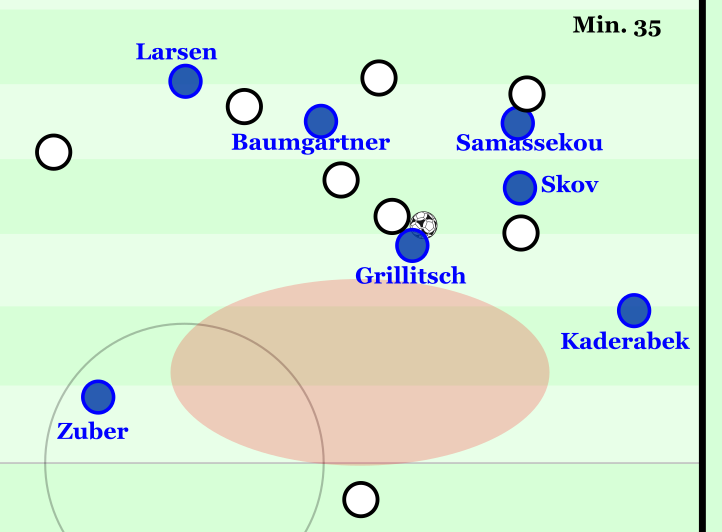
Concluding
The discussed aspects were observed in the ten games after the re-start. The bottom line is that Hoffenheim is a highly skilled team. Their principal strength and focus lays in the ball possession phase with interesting plays and mechanisms. In this regard Hoffenheim can keep up with Bundesliga’s top teams. To what extent they can show such performances over a longer period of time – at the same time with the additional strain in the Europa League – remains to be seen as key question for the upcoming season. The integration and development of youngsters like Bogarde and Beier is of similar importance by leading them to more appearances and more consistent performances. It will be exciting to observe how quickly they can become serious starting options. The decision for Sebastian Hoeneß as new head coach is a clear sign for the club’s emphasis on the recently demonstrated offensive and dynamic-aggressive playing style and the integration of the aforementioned young talents. If the new coaching team succeeds in continuing this development while bringing the counter pressing and transition into defence to the next level, Hoffenheim can reach the qualifying positions for the Europa league.
Writing: Tobias Meyer
Keine Kommentare vorhanden Alle anzeigen